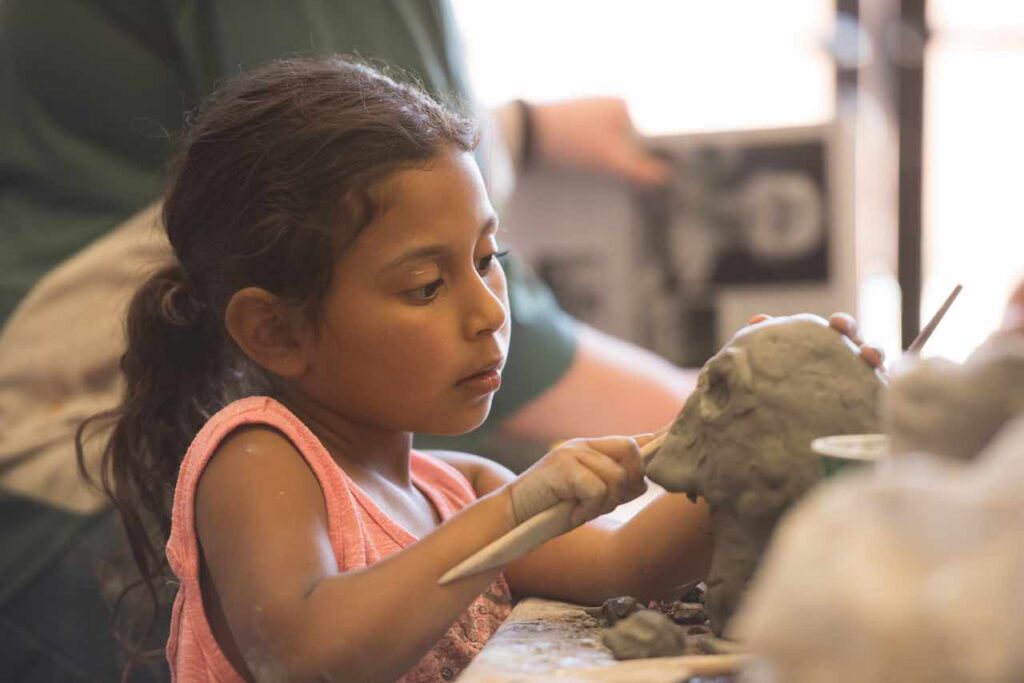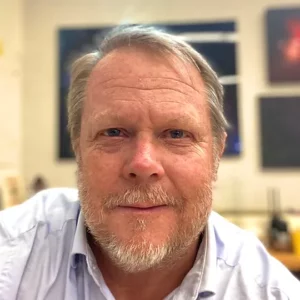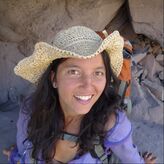We remain committed to our long-term vision, so short-term challenges don’t become devastating.
Natasha Efross, MENTOR
Q: What paths led each of you to launching Rock Tree Sky?
Jim: I spent 15 years in the classroom before Natasha and I took the leap with Rock Tree Sky. However, education wasn’t my initial path. I took time off from college in my early 20’s and worked in customer service, which I believe helped me see my role as a teacher from a completely different perspective—one of service, rather than authority.
After receiving my degree, I entered my first classroom as a professional when I was 31 years old. I was really excited and certain teaching was what I wanted to do, but I was immediately disappointed by the system I stepped into. The students’ voices were rarely included in conversations about their own education and at times it felt intentionally so. There was a clear sense of hierarchy—an authoritarian model of leadership. Some of my colleagues tried to convince me this was just the way it was done, but it didn’t sit right with me.
Early on in my teaching, I believed discovering where my students were at—academically and in life—was important. I wanted to get connected and then bring them along on a journey. I wanted to take that customer-service lens and saw myself as working for the students and their families.
As I continued incorporating this relationships-first mindset in my teaching, I ended up meeting Natasha while working at a private school here in Ventura County. She was working as a dorm parent and helping the high schoolers in various ways. Natasha’s daughter was six or seven at the time our relationship began, and Natasha noticed her daughter’s curiosities and ideas had no room to breathe in her learning environment. I’ll let Natasha talk more about this part of the story.
Natasha: Going back to my own time in school, I was the kid in elementary school who was always in the nurse’s office. I was there every week, faking one illness or another. I related to school like the vegetables you have to eat no matter how bitter they taste. My parents didn’t know any different, and neither did I until my older sister had me read The Teenage Liberation Handbook: How to Quit School and Get a Real Life and Education by Grace Llewellyn.
I ate that up and in a matter of weeks, I walked off my high school campus and never turned back. I got my high school equivalency and started going to community college. I continued reading about education and spent my time exploring the unschooling movement through authors like John Taylor Gatto, John Holt, and others.
That exploration went dormant when I had my daughter, but during that time I went ahead and got my teaching credential with plans to deliver the same kind of starry-eyed, idealistic model of education I had read in those books. I thought maybe if I went into the classroom with this different perspective, I could make it different for the kids I served. I believed I could be bigger than all the other forces that may have prevented me from excelling in school as a kid.
The students involved in the deepest learning and who had the best retention were the ones I could tell were making that choice out of their own interests. It wasn’t my choice; it was clearly theirs.
Jim Bailey, MENTOR
I did some student teaching and realized those ideals wouldn’t be realized, so I opted instead to focus on being a mother for a few years. Once my daughter was of age, I enrolled her in what seemed like a progressive school that appeared to really question some of those core assumptions about what education should be. It was a lovely community, and it was a lovely first few years for my daughter. But, like Jim said, as I saw her getting older, I started having my own flashbacks as a young child who would refuse or dig my heels in when told to do things I wasn’t interested in doing.
When I started seeing little hints of that and my daughter not wanting to go to school sometimes, I felt conflicted as a parent and educator thinking I needed to make her go. That was my red flag. I knew I needed to take a step back.
I began considering homeschooling, and then I started reading Peter Gray’s Free to Learn. I had a reawakening of everything I had studied about a decade earlier when I left high school.
Jim: We had a lot of dialogue about that book because his central claim that children learn best when given free choice went against all of my conditioning about how learning happens. It sounded nothing like the methodology classes I had in my credential program. I thought, “Wait a second, I’m the teacher. I’m teaching the kids these things.”
As Natasha shared more of Dr. Gray’s book, I found myself reflecting on how learning was happening in my own classroom. The students involved in the deepest learning and who had the best retention were the ones I could tell were making that choice out of their own interests. It wasn’t my choice; it was clearly theirs. Other students, who might have been joining along out of duty or concern about grades or parental expectations were clearly less interested and, ultimately, less able to engage in meaningful dialogue with me later about that topic.
What I recognized in Peter Gray’s words, and what was a paradigm shift for me, was the power of the learner being at the center of the teacher-student relationship and ensuring they got to choose whether they wanted to come along with me on the journey or not. And, that it was my responsibility to follow their interests, curiosities, and passions.
Natasha: When I chose a different path for my daughter, I thought it would be important for her social development to invite a few friends to join in this little experiment. I knew my daughter would be happier with peers around. Jim was intrigued by the possibilities and, as a trusted teacher and mentor in the area, when he made the leap to join in, the little experiment quickly grew into a full-fledged program.
The growth of the program and interest from parents shifted the whole project. Neither of us expected it to grow from 17 to over 100 students. We never thought we would work with high school students. There were a lot of pieces we never thought we’d entertain. But, the calls just kept coming, the people just kept coming, and now here we are.
Q: Growing in such an organic way and with so much parental interest, do you see Rock Tree Sky influencing other learning environments in the Los Angeles area?
Natasha: There’s a logistical piece of wanting this kind of education to be accessible to the larger community. We need to figure out how to fund our work and not become another private progressive school that can only be accessed by a small number of families. We want to build bridges with public schools.
We sit in a unique position as an independent enrichment center. We aren’t a school like a public district or charter or a conventional private model—this gives us the freedom to stay true to our mission. We serve homeschooling families or families engaged in independent study. But, some of our families access Rock Tree Sky as a vendor of their public charter school or local district. This provides public funding so that a wider demographic can access our program.
In California, there’s a lot of tension between public charter schools and public districts. By wanting to build bridges with public districts, we have to find a way to communicate beyond that friction of serving charter students. We are currently in conversations with our local public district to operate as a vendor for students who are choosing independent study opportunities.
Working with public districts is one of two big opportunities we’re excited about. The other is truly engaging with the community at-large. We love the idea of having an open-walled campus and perhaps setting up a co-working space on the property. We’d love to have kids going out into the community for internships and having professionals right on campus. I’ve been really inspired by what Iowa BIG and other models are doing. Creating these relationships takes time, but it’s part of our long-term vision. We want to feel more like a learning community and less like a little learning warehouse.
Q: What has been one of your favorite stories of learning at Rock Tree Sky?
Natasha: The oldest student we’ve had to date came to us as a Sophomore. He was on the upswing from a bout of depression he had been battling for some time. He was looking for the pieces that he wanted to add to his life to really support him on his journey out of that, and we happened to be one of those pieces. Ironically, he was a child of one of the school board members.
We were initially nervous by the challenge because we hadn’t created experiences for someone his age before. Could we keep him engaged and feeling challenged? But, we discovered that what our program naturally provides—deep relationships with mentors and peers—was exactly what he needed.
He found the perfect balance between engaging in intellectually challenging work with mentors—particularly one mentor who shared his love for literature—and playful leadership as he played the role of dungeon master in Dungeons and Dragons with our younger learners.
Through that, he continued to blossom in all parts of his life, and that was a really joyful thing to witness. He took full advantage of the support and freedom that was given to him and was able to lean into his passions. Whether he was interested in blacksmithing, furniture-making, or reading great books, he had the support to explore anything.
He has since graduated and currently lives in New York. He’s wanting to become a writer and continues exploring the world around him. So, that’s one of the stories that we love to share.
Jim: We had a public school reach out to us about a fourth-grade boy who was really bright, but the teacher recognized a conventional classroom wasn’t serving him well. He was an abstract thinker and sitting down analyzing an essay or poem was really tough on him. She could see he needed to move more.
His family came up and visited, and he started coming to us three days a week. You could tell he was one of those kids that would stir up trouble because he was either bored or unchallenged. When he first arrived, he was kind of uncertain about what to do—he wasn’t used to choosing for himself.
But, he soon started jumping in on woodworking projects and realized he could breathe a little bit in this space. He saw he could follow things he was interested in, and he started smiling a lot more. At one point, he became interested in metal detecting. So, he asked, “Jim, can I bring my metal detector?” Of course, I said, “Yes.” We’re located within an old elementary school campus that has a big area to explore outside.
He brought his metal detector, and he would go metal detecting and find coins. Then, he would research them online to discover where they were minted. I thought it would be interesting to find out exactly how a metal detector works, so he explored that as well. To see him turn around like that and have a sense of ownership in his learning was really beautiful.
Q: Do either of you think you could have made Rock Tree Sky happen by yourself?
Jim: No.
Natasha: No.
Jim: I think about this a lot. If somebody had this vision and really wanted to do it, I can’t imagine how hard it would be without a right-hand person. I’ve been asked this question before, and the very least that I recommend to people looking to start their own learning environment is to hire someone who can handle the administrative or technology pieces. If you take it all on yourself without hiring anyone, I worry how long it will last.
Natasha: I would also say what our relationship has provided, that even hiring somebody wouldn’t, is knowing how to manage crises together. Being married allows you to start something like this with that experience already baked in. We’ve experienced pressure around our funding model as charter schools get pressured; we’ve seen family “allegiances” shift; we’ve had other unique surprises. But, in each instance, we keep learning. We remain committed to our long-term vision, so short-term challenges don’t become devastating.
Having somebody alongside to meet those challenges head on has allowed us to become sustainable. I don’t know if that would be the case without that person to take a deep breath with and regain perspective and remember what the bigger mission is and that it’s about children. A reminder that it’s not about money or some other less significant measure of success. Those are important reminders to share back and forth.
Q: As you continue building a more sustainable learning environment, what do you wish people asked you more about the work you do at Rock Tree Sky or education in general?
Jim: As we become better known within our community, I want people to ask how they can bring some of what we’re doing into a conventional classroom. I’ve been to every school board meeting for the last two years—kind of ferrying this along. What I love is the dialogue I get to have with my colleagues who are working in public schools and with school board members. It’s been an opportunity to talk with them about project-based learning and how schools like Avalon School in Minnesota, for example, are able to integrate PBL practices, while still tracking the standards required by the state.
So, I wish my colleagues would dig deeper into how they can integrate this work with their students—providing the space for more autonomy.
Natasha: I get a lot of questions about educational efficacy. What knowledge are students attaining, and how is it being measured? When I hear these questions, it’s such a relief to come across people who ask more about the well-being of the children, the well-being of the community, and the well-being of the learning environment. Does Rock Tree Sky feel caring? Are the people here attuned to the needs of the children and their families? Those are questions that I really love to talk about.


